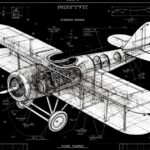The oblique wing aircraft, also known as pivot wing or slewed wing aircraft, represents a radical departure from conventional aircraft design, offering the potential for significant improvements in aerodynamic efficiency, fuel economy, and performance across a wide range of speeds. Unlike traditional fixed-wing or swept-wing designs, the oblique wing features a single wing that pivots obliquely relative to the fuselage, allowing it to adjust its sweep angle dynamically during flight. This unique configuration enables the aircraft to optimize its aerodynamic properties for different flight conditions, making it a promising candidate for future aviation applications.
History
The concept of the oblique wing dates back to the mid-20th century, when aeronautical engineers began exploring unconventional designs to overcome the limitations of traditional aircraft configurations. One of the earliest proponents of the oblique wing was German engineer Richard Vogt, who proposed the idea in the 1940s. However, it was not until the 1970s that the concept gained significant attention, thanks to the work of NASA engineer Robert T. Jones. Jones conducted extensive theoretical and experimental studies on oblique wings, demonstrating their potential for supersonic and subsonic flight.
NASA’s interest in oblique wings was driven by the need for aircraft capable of efficient performance across a wide speed range, from subsonic to supersonic. The agency constructed several test models, including the Oblique Wing Research Aircraft (OWRA), to validate the concept. These experiments confirmed that oblique wings could achieve reduced drag and improved lift-to-drag ratios compared to traditional swept wings. Despite these promising results, the oblique wing concept faced numerous technical and practical challenges, which limited its adoption in mainstream aviation.
Design principles
The oblique wing aircraft is characterized by a single wing that rotates around a pivot point on the fuselage, allowing it to assume an oblique angle relative to the aircraft’s longitudinal axis. This design enables the wing to adjust its sweep angle dynamically, optimizing its aerodynamic properties for different flight conditions. For example, at low speeds, the wing can be positioned perpendicular to the fuselage (zero sweep), maximizing lift and stability. At high speeds, the wing can be pivoted to a highly swept position, reducing drag and improving supersonic performance.
The aerodynamic behavior of oblique wings is fundamentally different from that of traditional swept wings. When the wing is swept obliquely, one side experiences a higher effective sweep angle, while the other side experiences a lower effective sweep angle. This asymmetry creates unique flow patterns, including crossflow and vortex generation, which can enhance lift and reduce drag under certain conditions. However, the asymmetric nature of the oblique wing also introduces challenges, such as roll instability and control complexity, which must be addressed through advanced flight control systems.
Advantages
One of the primary advantages of oblique wing aircraft is their ability to achieve high aerodynamic efficiency across a wide range of speeds. By adjusting the wing’s sweep angle, the aircraft can optimize its lift-to-drag ratio for both subsonic and supersonic flight. This capability makes oblique wings particularly well-suited for applications requiring variable-speed performance, such as military reconnaissance and commercial supersonic transport.
The improved aerodynamic efficiency of oblique wing aircraft translates into reduced fuel consumption, which is a critical consideration for both economic and environmental reasons. Studies have shown that oblique wing configurations can achieve significant fuel savings compared to traditional swept-wing designs, particularly at high speeds.
Oblique wing aircraft are highly versatile, capable of performing efficiently in a variety of flight regimes. This versatility makes them attractive for a wide range of applications, including long-range transport, high-speed reconnaissance, and unmanned aerial vehicles (UAVs).
Unlike variable-sweep wing designs, which require complex mechanical systems to adjust the wing’s sweep angle, oblique wing aircraft achieve variable sweep through a single pivot mechanism. This simplicity reduces weight and maintenance requirements, further enhancing the aircraft’s performance and cost-effectiveness.
References
Jones, R. T. (1972). “Reduction of Wave Drag by Oblique Wing Configurations.” NASA Technical Memorandum, TM X-62, 1972.
Smith, J. H. (1980). “Aerodynamic and Structural Considerations for Oblique Wing Aircraft.” Journal of Aircraft, Vol. 17, No. 4, 1980.








